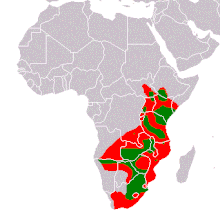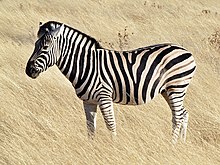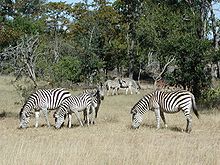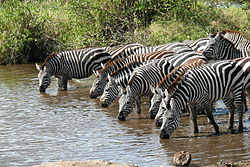平原斑马
| 平原斑马 | |
|---|---|

| |
| 平原斑马,拍摄于坦桑尼亚恩戈罗恩戈罗保护区(Ngorongoro Crater)。 | |
| 科学分类 | |
| 界: | 动物界 Animalia |
| 门: | 脊索动物门 Chordata |
| 纲: | 哺乳纲 Mammalia |
| 目: | 奇蹄目 Perissodactyla |
| 科: | 马科 Equidae |
| 属: | 马属 Equus |
| 亚属: | 斑马亚属 Hippotigris |
| 种: | 平原斑马 E. quagga
|
| 二名法 | |
| Equus quagga Boddaert, 1785
| |
| 亚种 | |

| |
| ■ 历史分布
■ 现代分布 | |
平原斑马(学名:Equus quagga)又名普通斑马,是东非和南非大草原上分布最广的一种斑马[2]。其分布范围从埃塞俄比亚南部直到非洲东部,往南至安哥拉和南非东部。平原斑马在动物保护区中仍十分普遍,但受人类活动如狩猎等威胁,其以往的栖息地亦被侵犯。
分类



和山斑马一样,平原斑马是斑马亚属(Hippotigris)中的一员,而与其近似的细纹斑马则是细纹斑马亚属(Dolichohippus)中唯一的成员。就体态而言,前两者像马,后者则像驴。虽然如此,DNA及分子生物学的数据显示,斑马有其独立的起源,但和马与驴同属马科马属。在肯尼亚及埃塞俄比亚的一些地区,平原斑马经常跟细纹斑马共享同一块土地。
亚种
平原斑马目前已经确认拥有六个亚种,而随着1883年斑驴绝灭后,现今只剩下五个亚种存活于世。1958年,生物学家在索马里一带发现可能是第七个平原斑马的亚种[3]:Equus quagga isabella。这个亚种可能是有效的,但目前尚无更多证据能够证明其为平原斑马的亚种。
以下是当今已被确认的亚种:
- 斑驴 Equus quagga quagga † – Boddaert, 1785
- 布氏斑马 Equus quagga burchellii - Gray, 1824
- 格兰特氏斑马 Equus quagga boehmi – Matschie, 1892
- 社氏斑马 Equus quagga borensis – Lönnberg, 1921
- 辑氏斑马 Equus quagga chapmani - Layard, 1865
- 克氏斑马 Equus quagga crawshayi – De Winton, 1896
已经灭绝的亚种斑驴最初在1778年被认为是一支独立的物种,学名为 Equus quagga。在接下来的50年之间,许多生物学家和探险家陆陆续续地对许多斑马做出描述。牠们最初被归类为斑马的“物种”,但透过分类学家更深入的研究后发现,有绝大多数都是平原斑马和山斑马的“亚种”。斑驴是史上第一个受到DNA研究的已绝灭动物,而史密森尼学会(Smithsonian Institution)最近一次的基因研究结果证明,斑驴并不是一支独立的物种,而是平原斑马的亚种,但其基因在29~12万年前和平原斑马产生了些微偏离。史密森尼学会表示,斑驴的学名应该改为 Equus burchelli quagga 。但是为了符合双名法的规则,学者们进一步将学名改为现在所使用的 Equus quagga quagga。
值得一提的是,亚种布氏斑马有一段时间被认为因人类过度捕猎而绝灭,但其实不然。因为2004年由格罗夫斯(Groves)和贝尔(Bell)两名学者的研究著作显示,布氏斑马现今仍在南非的夸祖鲁-纳塔尔省(KwaZulu-Natal)一带生活着。[4]
身体特征
平原斑马体型中等规模,腿相对较短。雄性和雌性的肩高均为1.4米,长度约2.3米,体重约220-322公斤。雄性的重量超过雌性10%。[5]
像所有的斑马,它们的身体为黑色和白色条纹,并且没有两个完全相同的个体。它们也有黑色或深色鼻口。身体的前部为垂直条纹,向后部逐渐过渡为水平条纹。北部品种条纹更窄一些,南部品种腹部、腿部和臀部条纹数目更少一些。南部品种在白色和黑色条纹中间间杂褐色条纹,而北部品种则没有或者很少。[6]
生态及行为

栖息地
平原斑马的分布相当广,分布范围从非洲东部的苏丹和埃塞俄比亚南部开始向南延伸,其范围包括赞比亚、莫桑比克、马拉维,最后到达南非东部以及位在非洲西南部的安哥拉。在人类的捕猎活动兴盛之前,布隆迪和莱索托也曾是平原斑马的栖息地。而在时间更早一点的新石器时代,阿尔及利亚也有可能是牠们的栖息地。[7]
平原斑马通常生活在没有树木的草原和热带原林地,跨越了热带及温带地区。[8]不过,牠们一般不会在沙漠、茂密的热带雨林和永久性湿地生活。[8]此外,牠们也会生活在肯尼亚山中海拔高度约4300米的地方。由于平原斑马需要大量的食物和水,因此牠们会随时往降雨的地方移动,且牠们一次可以走上700英里(1,100千米)来寻找食物。平原斑马高度依赖于水,所以斑马群通常会在距离水源区25~30公里处活动。[9]
平原斑马属于群居动物,经常与斑纹角马展开大规模迁徙,往返于肯尼亚马赛马拉国家保护区与坦桑尼亚塞伦盖蒂国家公园之间。
天敌
平原斑马的主要天敌是狮子和渡河时容易遇到的尼罗鳄。斑点鬣狗、非洲野犬、花豹也会捕食斑马,但牠们对平原斑马的威胁较为次要。[10]
参见
参考文献
注释
- ^ (英文)Hack, M.A & Lorenzen, E. 2008. Equus quagga (页面存档备份,存于互联网档案馆). In: IUCN 2009. IUCN Red List of Threatened Species. Version 2009.2. <www.iucnredlist.org (页面存档备份,存于互联网档案馆)>. Downloaded on 2009-11-20.
- ^ Grubb, P. Order Perissodactyla. Wilson, D.E. & Reeder, D.M. (编). Mammal Species of the World: A Taxonomic and Geographic Reference (3rd ed.). Baltimore, Maryland: Johns Hopkins University Press. 2005: 630. ISBN 978-0-8018-8221-0. LCCN 2005001870. OCLC 62265494. NLC 001238428.
- ^ (英文) Hack, M.A., East, R. & Rubenstein, D.I. 2008. Equus quagga ssp. quagga (页面存档备份,存于互联网档案馆) <www.iucnredlist.org>. Downloaded on 2009-11-20
- ^ Groves, C.P. & Bell, H.B. 2004. New investigations on the taxonomy of the zebras genus Equus, subgenus Hippotigris. Mammalian Biology. 69: 182-196.
- ^ 存档副本. [2010-11-13]. (原始内容存档于2010-12-26).
- ^ 存档副本. [2010-11-13]. (原始内容存档于2010-11-17).
- ^ Groves C. P. (1974) Horses, Asses and Zebras in the Wild. Ralph Curtis Books, Hollywood
- ^ 8.0 8.1 Moehlman 2002
- ^ Estes 1991
- ^ Kingdon 1979
一般引用
- Alden, P. C., Estes, R.D., Schlitter, D., McBride, B. (1995). National Audubon Society Field Guide to African Wildlife. New York, Chanticleer Press, Inc. pg. 151
- Estes, R. (1991). The Behavior Guide to African Mammals, Including Hoofed Mammals, Carnivores, Primates. Los Angeles, The University of California Press. pgs. 242-246
- Groves, C.P. & Bell, H.B. 2004. New investigations on the taxonomy of the zebras genus Equus, subgenus Hippotigris. Mammalian Biology. 69: 182-196.
- Hack et al. Equus burchellii. The IUCN Red List of Threatened Species 2002. [17 June 2006].
- Hack et al. Equus quagga. The IUCN Red List of Threatened Species 2002. [10 May 2006]. (Extinct subspecies of the Plains Zebra.)
- Higuchi et al. 1987. Mitochondrial DNA of the Extinct Quagga: Relatedness and Extent of Postmortem Change. Journal of Molecular Evolution 25:283-287.
- Kingdon, J. (1979). East African Mammals: An Atlas of Evolution in Africa, Volume 3, Part B: Large Mammals. Chicago, The University of Chicago Press. pgs. 165-179
- Klingel, H., 1969. Reproduction in the plains zebra Equus burchelli boehmi: behaviour and ecological factors. J. Reprod. Fertil., Suppl. 6: 339-345.
- Moelman, P.D. 2002. Equids. Zebras, Assess and Horses. Status Survey and Conservation Action Plan. IUCN/SSC Equid Specialist Group. IUCN, Gland, Switzerland. pgs. 43-57
- Moehlman, P. D. (2003). Grizmek's Animal Life Encyclopedia. Mammals IV. Detroit, The Gale Group, Inc. 15.
- Moss, C., Ed. (1982). Portraits in the Wild, Animal Behavior in East Africa. Chicago, The University of Chicago Press.
| ||||||||||||||||||||||||||||||||||||||||||||||||||||||||||||||
|
Text is available under the CC BY-SA 4.0 license; additional terms may apply.
Images, videos and audio are available under their respective licenses.




